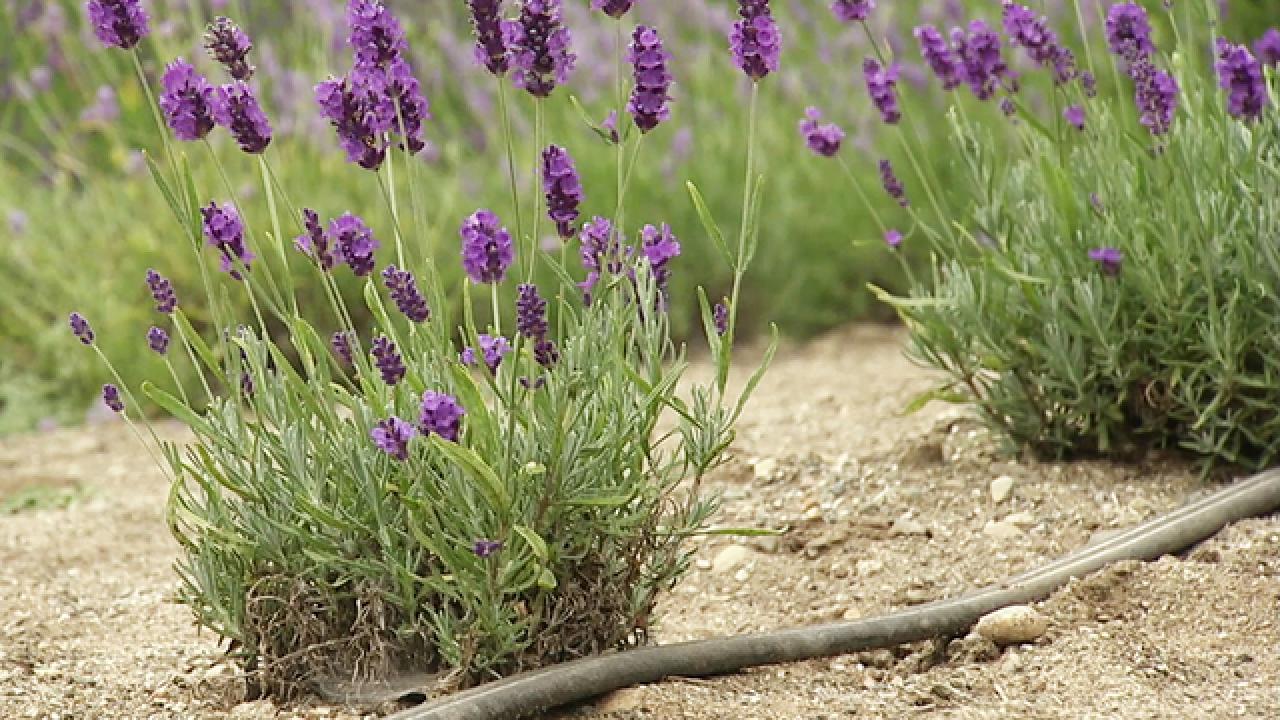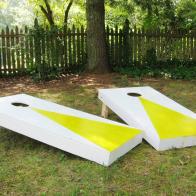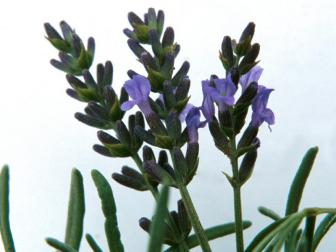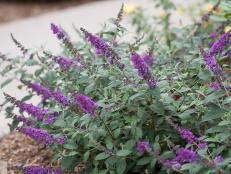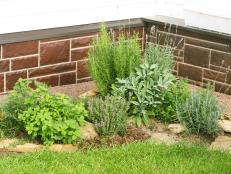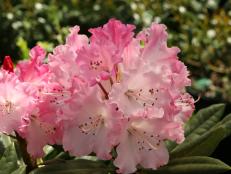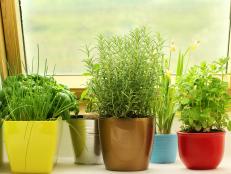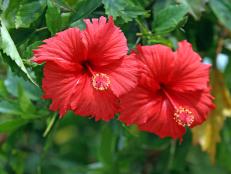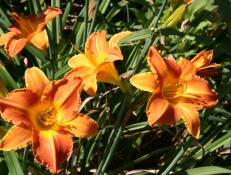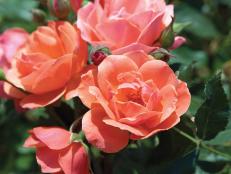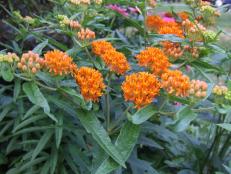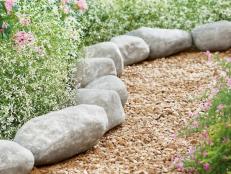How to Plant, Grow and Care for Lavender
Grow lavender in your garden and you’ll be rewarded with colorful flowers, wonderful fragrance and a feast for pollinators — all from a low-maintenance plant.
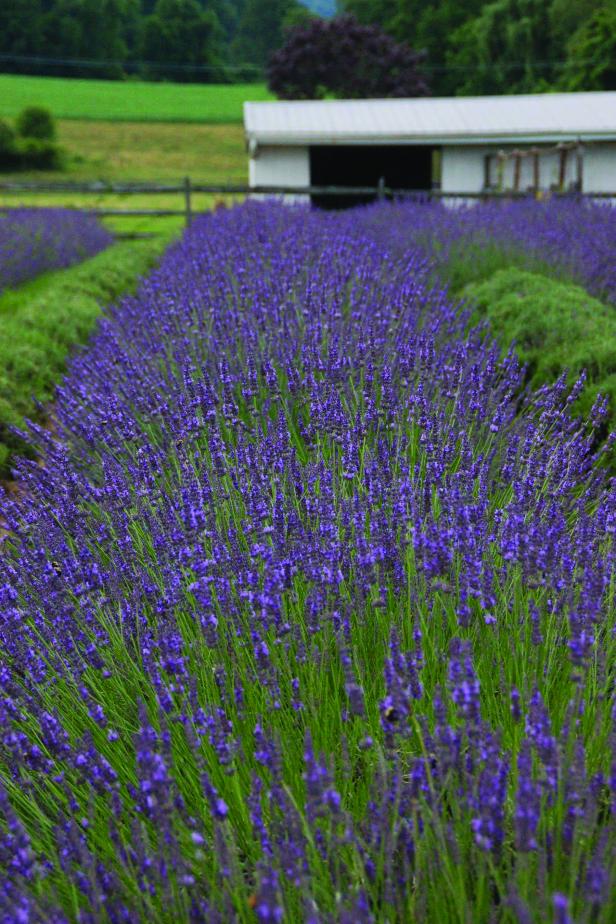
Image courtesy of Burpee
Lavender plants produce gray-green leaves that are packed with a refreshing, sweet-herbal scent, and pretty, abundant flowers that bear the same perfume. Both the leaves and flowers are edible, making this plant a must-have for any herb garden. Lavender plants most often open purple blooms, but you can also find different types of lavender that have pink or white flowers. Growing lavender isn’t a difficult proposition. Once you master the basics of giving plants a proper site and pruning regularly, you’re on your way to a gorgeous, productive perennial.
Botanical Name: Lavandula spp.
Common Name: Lavender
Plant Type: Perennial herb, semi-shrub
Bloom Time: Summer
Light Needs: Full sun
Soil Needs: Drier, well-draining, slightly alkaline
Hardiness Zones: 5 to 11
Soil Preparation and Planting Lavender
Growing lavender well starts with planting lavender well. All types of lavender need full sun to thrive. Native to the western Mediterranean, lavender is a sun worshipper and can take up to six hours of direct sun daily. The exception is in the Deep South and Southwest, where a little protection from sizzling afternoon sun is welcome. You can amplify the heat plants receive by using a stone mulch or tucking lavender into planting areas near surfaces that radiate heat, like a stone wall, driveway or south-facing building wall.
In Zones 3 to 7, plant lavender in spring after all danger of frost has passed. If you must plant in fall, do so at least eight weeks before the average frost date. Lavender grows fastest in heat, so as temperatures drop in autumn, growth slows down dramatically. Fall-planted lavender needs ample time to develop a sturdy root system to survive winter. In Zones 8 and warmer, planting lavender can be done in spring or fall.
While lavender can be grown indoors in a pot, this plant far prefers to be grown outdoors rather than being treated as a houseplant.
Soil Prep
When planting lavender, you want soil that drains well and is slightly alkaline. Drainage is vital because lavender plants often die from root rot due to soggy soil. In regions where lavender is winter hardy, consider winter drainage, too. Soils that tend to hold water in winter can kill lavender quickly.
Many gardeners enhance drainage by planting lavender into raised soil mounds 12 to 24 inches tall. This provides the sharp drainage that lavender demands and it also helps in situations where native soil is clay that doesn’t drain well. Mix sharp sand or small limestone fines into soil to enhance drainage.
To achieve alkaline soil, mix some crushed oyster shell or limestone gravel into planting holes. You might even excavate a slightly deeper planting hole and fill the bottom two-thirds of the space with limestone gravel. This helps improve drainage in heavy soils and provides an alkaline environment for roots. Some gardeners also add a mixture of lime, bone meal and compost to planting holes to get alkaline pH and jump-start growth. Aim for about a half-cup total using equal parts of those items.
Spacing and Planting
This is one perennial that doesn’t take well to overcrowded conditions. When planting lavender, give it enough elbow room to accommodate flowers. Ideally, try to space plants as far apart as they’ll grow tall. Lavender needs good air circulation to grow at its best.
Most gardeners plant lavender transplants rather than starting from seed. When you’re planting lavender transplants, dig a hole that’s deep enough for the plant’s roots and tuck the plant into place, snugging soil around it. Plant lavender no more more deeply in the ground than it sat in its nursery pot.
When planting lavender, prune plants lightly, removing all growing tips. This encourages the plant to branch. Use this same technique every year as new growth starts to appear. Water until plants show steady new growth.
Starting From Seed
Most lavender is grown from cuttings, which helps get a plant true in characteristics to the parent plant. That's why most gardeners plant from transplants rather than seed. Growing from seed is difficult, but it's not impossible.
If you want to try starting lavender from seed, sow seeds in a sterile seed starting mix. Barely cover seeds, because they need light to germinate. Lavender seeds can take as long as a month to germinate, although sometimes they’ll sprout in as little as 14 days. Help the germination process by placing seed trays in a warm spot: 70 degrees is an ideal temperature. Some gardeners refrigerate seeds in a sealed plastic bag for 21 days to prepare them for sprouting and help improve germination.
Transfer seedlings to 2-inch wide pots when seedlings have sprouted several sets of leaves. Lavender is a slow grower and may take one to three months to reach transplanting size. The greatest threat to lavender seeds and seedlings is fungus. Keep soil mix moist, but provide good air circulation to help reduce disease outbreaks. Acclimate seedlings to outdoor growing conditions when lavender plants are 3 inches high.
Growing and Harvesting Lavender
Once established, lavender grows best with neglect. If you plant your lavender in a sunny spot in well-draining, slightly alkaline soil, maintain good airflow through pruning and don’t overwater. Your lavender should grow beautifully.
Pruning Lavender
Pruning is key to successfully growing lavender. Prune lavender in late summer to fall — after the plant flowers — to help open the plant’s interior to allow good air circulation and remove some of the branches, which can ultimately help prevent winter damage. Pruning lavender in spring to remove stems that suffer in winter is also sometimes necessary in coldest regions.
When you’re pruning lavender plants that are established, aim to remove at least one-third of all growth. Don’t cut into the woody area because the buds on those stems won’t sprout.
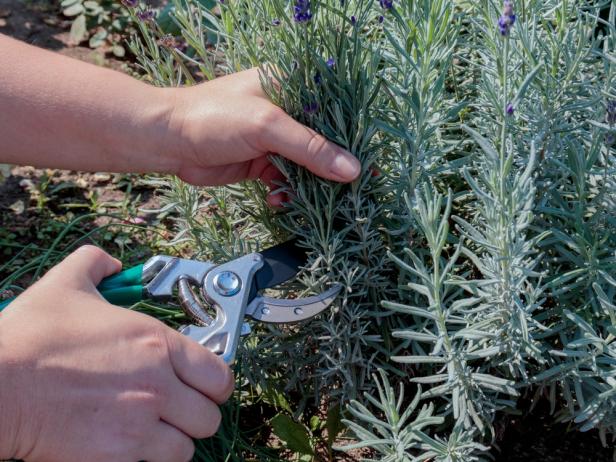
Shutterstock
Prune lavender in fall with hand pruners. Cut back green stems, not woody ones.
In botanical circles, lavender is known as a semi-shrub — a plant that grows like a perennial, producing green growth each year. The older parts of stems on a semi-shrub start turning to wood after a few growing seasons. When you’re pruning lavender plants, you’re aiming to slow down the plant’s progress toward forming woody stems. Lavender’s woody stems don’t produce new green growth, so as stem tissue shifts to wood, your plant is losing the ability to produce additional green shoots, which are the ones that flower.
Harvesting Flowers
Lavender plants flower in summer and you can harvest as much as you want — just leave some of the buffet for the bees. Plants achieve their peak bloom usually during their third growing year. For most healthy, mature plants that aren’t overcrowded, you can expect to see up to 1,000 flower stems per plant.
Cut stems with sharp scissors or pruners.
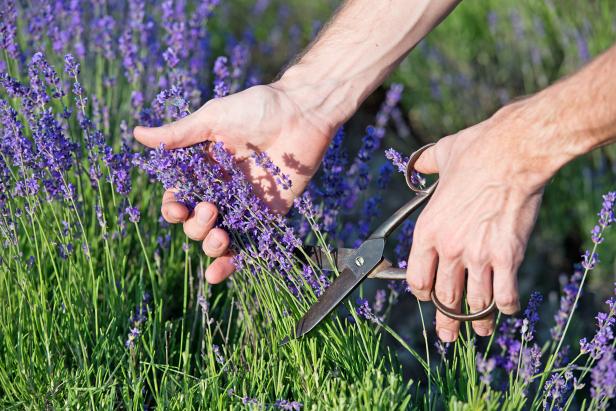
freya photographer / Shutterstock.com
For culinary use, harvest lavender flowers when the buds are fully open and fragrant.
- If you’re harvesting lavender flowers for cooking, choose ones that are fresh and fully open. Avoid picking blooms that are spent and dried up.
- To harvest lavender flowers for bouquets, cut stems when roughly 3/4 of the individual buds on a flower spike are open. When that many blossoms are open, you should see a few of the lower buds open, too. This is an ideal time to harvest lavender flowers because the essential oil concentrations are highest, which means you’ll have a rich fragrance from the blooms.
- Dry lavender flowers by gathering them into bunches and hanging them upside down in a dry, dark, warm place. Or arrange lavender flowers upright in a vase without water. With either method, drying time depends on relative humidity, but you should have dried lavender flowers in 7 to 14 days.
Saving Seedlings and Seeds
In the garden, lavender will self-sow, especially when plants are surrounded with a gravel mulch. The gravel bedding provides an ideal seed sprouting environment. Allow plants to reach at least 3 inches tall before digging to transplant.
You can also harvest your own lavender seeds from plants. Wait until plants have bloomed, then snip flowering stems and gather them into bundles. Hang the bundles upside down inside paper bags. As seeds ripen and fall out of the flowers, they’ll land in the bag. Once flowers are dry, rub or strike them against the paper bag to release all seeds.
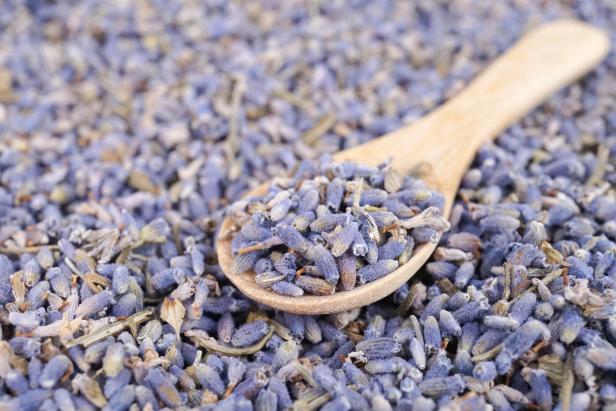
enchanted_fairy/Shutterstock.com
Lavender seeds form inside the flowers and can be separated from the flower heads by shaking them gently after drying.
Lavender in Garden Design
In the garden, lavender flowers stage a long-lasting show each summer. The purple blooms beckon all kinds of pollinators, including bees, butterflies and hummingbirds. A host of beneficial insects also visit flowers, making lavender plants an ideal addition to a wildlife or butterfly garden. On the other hand, lavender is one of many deer-resistant plants — which is all the more reason for rural gardeners to plant it.
Consider lavender flowers in a xeriscape design. Established plants are relatively drought-tolerant and do best when they don’t receive supplemental watering (except in times of severe drought). When it’s in flower, lavender has a strong architectural shape that suits modern, geometric garden designs. Surround your plants with gravel to enhance the modern ambience.
As a Mediterranean native, lavender is ideal in a perennial herb garden alongside fellow Mediterranean herbs such as sage, rosemary, oregano and thyme. All of these plants prefer similar soil and sun conditions.
Lavender is also a natural fit in a summer cutting garden. Lavender plants achieve their peak bloom usually during their third growing year, in summer. You’ll reap plenty of bouquets when plants start flowering—and you can also dry lavender to use in bouquets and crafts.
With its strong fragrance and flowers that attract bees and other pollinators, lavender makes a good general companion plant in a vegetable garden or orchard. Its especially useful for repelling pests from brassicas such as cabbage and broccoli.
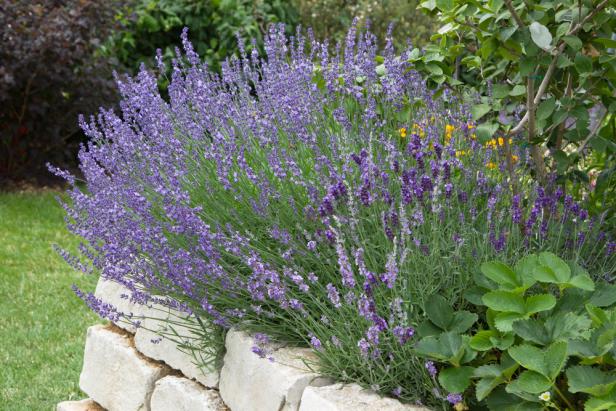
Shutterstock
Lavender thrives along a rock wall that absorbs heat and allows for excellent drainage around roots.
Uses for Lavender
The use of lavender dates back many centuries. The Egyptians used it in the mummification process and Romans bathed in it. Lavender, whose botanical name is "Lavandula," comes from the Latin "lavare" which means "to wash."
While you can add lavender to your bath today, too, the most common uses for lavender — and the best ways to enjoy its many benefits — are in cooking and in crafting.
- Lavender flowers and young leaves have many culinary uses. They infuse a sweetly herbal flavor into desserts, beverages, sauces and marinades. Lavender can stand in for rosemary in recipes. Use twice as much lavender as rosemary.
- Use lavender to add some savory flavor to meat marinades or rubs. When pruning lavender, toss stems onto hot grill coals to infuse meat and veggies with a delicious, smoky, herbal flavor.
- Pick lavender blooms to use in fresh bouquets or to dry. Drying lavender is one of the easiest floral projects you’ll undertake. Use dried lavender to make lavender bouquets or lavender wreaths.
- Separate lavender buds and blooms from the flower heads and use them to make sachets or potpourri. Lavender buds also make a terrific addition to handmade soaps or candles.
- Make lavender aromatherapy oil. All you need is lavender buds or flowers, plus a few more simple ingredients you likely already have on hand.
Fresh Ideas for Lavender
Tap into the versatility of lavender by learning ways to use this delightful herb.
Types and Varieties of Lavender
Feed your passion for fragrance by planting different types of lavender. Few herbs match this group for producing perfumed blooms and leaves that can scent a garden or a room when tucked into a vase.
English Lavender
English lavender (Lavandula angustifolia) is probably the most famous and familiar type of lavender and it is sometimes called “true” lavender. A native of the Mediterranean region, English lavender earned its common name because it grows well in the English climate. It forms mounding plants roughly 2 to 3 feet tall and wide. The grey-green leaves are scented and eye-catching on their own. When wands of purple flowers appear, the effect is exquisite. English lavender is often used as a low hedge and it’s also a favorite culinary lavender because of its sweeter taste.
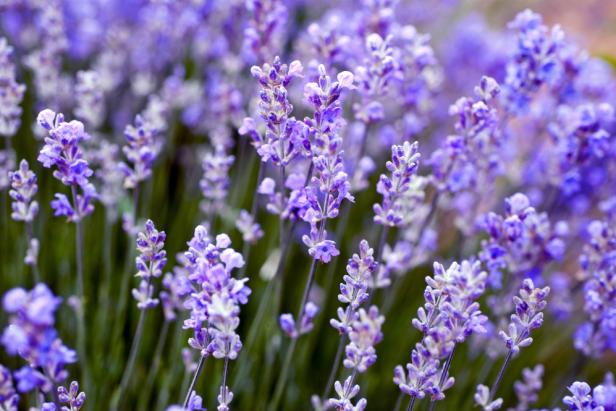
Shutterstock
English lavenders are the most popular and best for culinary use.
English Lavender Varieties
‘Hidcote’ English lavender (Lavandula angustifolia ‘Hidcote’) has earned a devoted following for its deep purple blossoms and tidy height. This sweetly scented beauty forms smaller mounds 12 to 18 inches tall and wide. It’s a wonderful choice for edging walkways or garden beds. The fragrant flowers also make this a tasty edible lavender.
‘Hidcote Blue’ lavender (Lavandula angustifolia ‘Hidcote Blue’) has a compact shape and is an ideal choice for a border hedge around planting beds. Also look for ‘Hidcote Pink’ lavender (Lavandula angustifolia ‘Hidcote Pink’), which opens pink blooms.
‘Munstead’ English lavender (Lavandula angustifolia ‘Munstead’) is another well-known type of lavender. It boasts the trait of better heat tolerance than other English lavender varieties.
This lavender was named after Munstead Woods, the home of renowned English garden designer Gertrude Jekyll.
Lavandin Lavender
Lavandin (Lavandula x intermedia) is a hybrid lavender that combines the cold tolerance of English lavender and heat tolerance of Portugese lavender (Lavandula latifolia). It has more essential oils and stronger camphor scents than other types. Grow lavandin for richly hued and scented flowers.
Lavandin Lavender Varieties
‘Grosso’ lavender (Lavandula x intermedia ‘Grosso’), is prized for its prolific, intensely perfumed blooms and its tolerance to heat. ‘Grosso’ is often raised commercially for essential oil that’s used in the perfume industry. It grows 2 to 3 feet tall and wide. Look for ‘White Grosso’ for a white-blossomed type of lavender. Grow the ‘Grosso’ types of lavender for a ready supply of blooms for crafting or cooking.
A Heat-Tolerant Hybrid
This English lavender hybrid performs in the garden and is beloved for its fragrance.
‘Provence’ lavender (Lavandula x intermedia ‘Provence’) is another lavandin that’s raised commercially, primarily in Provence, France. It’s prized for its fragrance-rich flowers on long stems. Grow ‘Provence’ lavender for making lavender wands and wreaths. Provence lavender has more of a peppery taste than English lavenders and is great for making herbes de Provence for savory dishes.
French Lavender
French lavender (Lavandula dentata) is more of a landscape plant and is hardy in Zones 8 to 11. Leaves and flowers have strong pine and camphor tones, which is why French lavender isn’t a culinary lavender type. French lavender flowers continuously, especially in regions with mild winters, creating a ready supply of flowers for sachet, potpourri and lavender wands.
Spanish Lavender
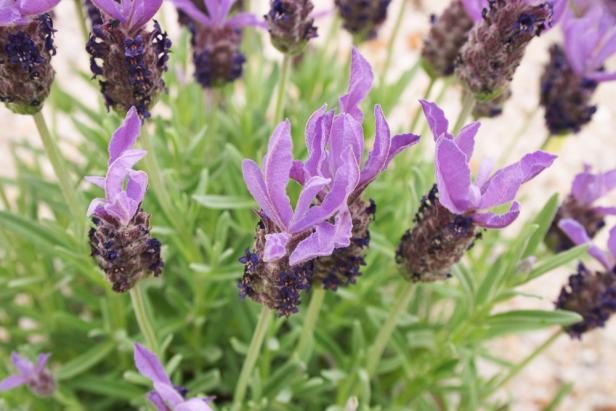
Shutterstock
Spanish lavender is grown for its unusual blooms.
Spanish lavender (Lavandula stoechas) is grown for its unusual blooms. The flower spikes are stouter than English lavender and petals stand upright, creating a flag effect. These lavender flowers are favorites in the garden and vase. Spanish lavender is also called stoechas.
